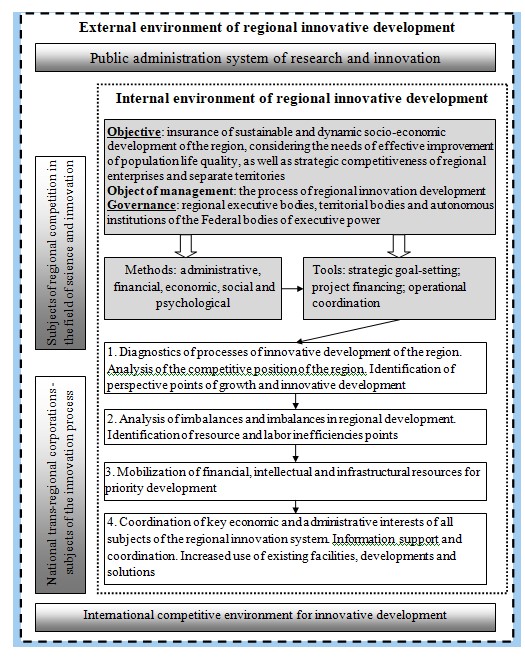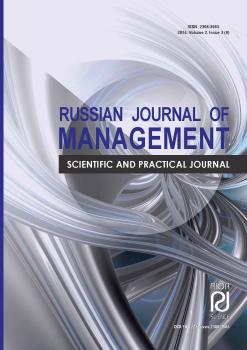Рязань, Рязанская область, Россия
ГРНТИ 06.54 Производительные силы и научно-технический прогресс
ГРНТИ 06.61 Территориальная структура экономики. Региональная и городская экономика
ГРНТИ 06.01 Общие вопросы экономических наук
ГРНТИ 06.39 Наука управления экономикой
ГРНТИ 06.52 Экономическое развитие и рост. Прогнозир-ние и планирование экономики. Экономич. циклы и кризисы
ГРНТИ 06.81 Экономика и организация предприятия. Управление предприятием
ОКСО 38.04.02 Менеджмент
ББК 65 Экономика. Экономические науки
ТБК 7833 Инновационный менеджмент. Интеллектуальная организация
В статье представлены результаты разработки инструментария стратегического управления и анализа инновационного развития регионов. Методология и методы. В числе методов научного исследования использовались системный подход, синтез, индукция и конструктивный метод. Результаты. Осуществлен анализ подходов к формированию инструментария стратегического управления инновационным развитием регионов. Обоснованы императивы осуществления управленческого влияния в изучаемой сфере на национальном и региональном уровне, а также на уровне отдельных территорий и корпоративных образований. Область применения. Результаты исследования могут быть применены для разработки методических рекомендаций в сфере регионального инновационного управления. Научная ценность. Выводы и предложения, представленные в работе, являются методическим базисом для дальнейшей конструктивной работы в изучаемой сфере.
инновации, развитие, региональная экономика, стратегическое управление, анализ
In the context of the dynamic development of the world economy, the sphere of innovations is the main driver of growth, determining the future of countries, regions and separate territories. The decline in the productivity of most mineral deposits indicates a decrease in the resource potential of most economies of the world. Reserves of industrial growth have exhausted themselves by the end of the twentieth century and now actually acquire negative values. The issues of efficient production and market competitiveness are solved in the framework of the innovation process. At the same time, competitive positions and leadership are determined for the strategic perspective. The lag in this direction is hard to be overcame. The avalanche-like, exponential growth of technological and innovative development of individual countries obtain such values that Russia's lag in this direction can determine negative economic prospects for our country for many future years.
It should be noted that in the conditions of significant imbalances in the territorial socio-economic development of Russia, the issue of ensuring the leading regional innovative development becomes relevant. The expansion of the spectrum of fundamental and applied research, as well as their commercialization at the regional level determines the attractiveness of regions for investment, the life standards of population, further prospects for socio-economic development. Among the positive factors ensuring breakthrough regional innovative growth it is necessary to determine the availability of infrastructure, human resources, educational, resource and production potential. A wide network of educational, scientific and industrial structures created during the Soviet Union period in the regions of our country is an essential organizational resource for ensuring future innovative growth. An important task is to make effective use of the existing potential and ensure its productive reproduction.
The problems of regional innovative development management is the subject of researches of V. Burkov, I. V. Burkova and V. Irikov [1], E Borisova [2], S. Zharov [3] A. Kuzubov [4] A. Kumpilov [5], A. Masloboeva [6], O. Mitkova and E. Dubik, [7], V. Ponomarenko and O. Annenkova [8], T. Pokhil'ko [9], B. Serbinovski and R. Makuchyan [10], E. Scurtu [11], I. Shagiev [12], N. Shashlo and G. Petruk [13; 14]. Among the priority areas of research colleagues identified the theory and practice of regional management of innovative development [1; 5; 7; 9], clustering of the economy and the allocation of priority zones of innovative growth [2], certain aspects of innovative development of the regions of the North and the Far East of Russia [3; 6; 13; 14], implementation of informational and telecommunication technologies at the regional level [4; 10]. Worth to be noted the works devoted to the improvement of public administration models of regional innovative development [8; 9], as well as the works concerning the questions of infrastructure support processes of regional innovative development [11; 12].
Despite the significant interest of the scientific community to the analyzed thematics, the high dynamics of social relations in the field of innovative development management determines the need to update the work aimed on improving the tools of analysis and strategic management of innovative development at the regional level.
In today's world, innovation is an essential element of business strategy. The regional development actors face the challenge of not situational decision-making, but the construction and deployment of integrated strategies for the development of innovation. The strategic approach to improvement of mechanisms of regional management of innovative activity is directed on increase of its contribution to scientific and technical breakthrough of all country, to development of economy of the territory and improvement of quality of life of its population.
It is obvious that in most regions of the Russian Federation, the primary expenditure of local budgets is aimed primarily on solving current problems and meeting the relevant needs. The costs associated with innovative development have less priority than solving the problems of the lack of infrastructure, import substitution, social development. At the same time, most of the regional subjects of the innovation process are institutions and enterprises of Federal subordination and, accordingly, are financed by the center. In this case, we should talk about the need to develop management tools aimed on increasing the efficiency of using the existing potential of the regional innovation system. Deficit in this situation is to a greater extent the organizational resource, which significantly exceeds the deficit of financial resources (which is typical for a number of regions).
The question of strategic priorities’ determining, as well as quantitative and qualitative characteristics of the main socio-economic indicators characterizing the parameters of innovation become relevant. It is necessary to understand clearly what results the regional power plans to provide as an output of implementation of the certain actions directed on achievement of reasonable strategic guidelines.
A specific programme of action on tactical and strategic perspective will allow regional management the opportunity not only to quickly solve the urgent problems and coordinate the work of all objects of the regional innovation system interested in the development of the region. The innovation process takes on the features of focus. In our view, the primary goal at the regional level should be to prepare the concept of the development of the region as a system of ideas about the strategic choice, goals and priorities for development, the main provisions in the context of its individual components and means of implementing these goals. Thus, the Concept of regions’ development, which determines the main priorities and characteristics of its innovative development, is the basis for the development of a strategic plan. Strategic plan for innovative development of the region is a mean for coordinating the efforts and determining intra-organizational relationships of all stakeholders and objects of management impact. On the next stage, forecast and analytical documentation is being developed. This documentation is aimed on the implementation of the concept and contains data on the relationship of resources, performers and the timing of events aimed on achieving the goals of sustainable innovative development of the region. Thus, the mechanism of sustainable innovative development of the region, directed on innovative breakthrough, is a system of measures that ensure the stable development of the economy under the conditions of consistency, productivity, resource efficiency of innovative reproduction of the regional system. On the basis of the above methodological basis we have substantiated the mechanism of strategic management of innovative development of the region (Pic. 1).

Pic. 1. Mechanism of strategic management of innovative development of the region
Identification of priorities of innovative development of regions should be carried out not only on the basis of objective resource, infrastructure or market conditions. The issue of compliance of the regional innovation policy with the national innovation strategy is relevant. Sectoral objectives should also be harmonized through horizontal coordination of sectoral programmes of the region. The balance of social, economic and environmental objectives through sustainable development planning also deserves special attention.
The strategy of regional innovative development ensuring should provide justification for a common position and common understanding of the changes taking place in the scientific and technical sphere of the region by all subjects of the regional system. They should engage in focused interaction and agree on the parameters of interaction for their joint work.
Regional authorities set priorities for the development of innovation in the region and consolidate the efforts and potential of all actors of the regional innovation system to implement the chosen development priorities. In the future, there is a plan of joint actions of the subjects on the development of innovation activities in the region. Some subjects of the regional innovation system are responsible for taking into account the strategy of development of the region, the strategy of innovative development of the state and coordination with the strategies of development of industries and strategies of innovative development of other subjects of scientific and technical activities operating in the region. The regional authorities together with the heads of the business community are largely responsible for creating and strengthening the image of the region as attractive for investment in innovative development.
In our opinion, the general algorithm of development and implementation of the strategy of regional innovative development ensuring should include the following stages: determination of resource, infrastructure and organizational reserves of ensuring breakthrough innovative development; justification of the mechanism of regional innovative development strategy’s elaboration considering the opportunities of multilevel subject participation; the analysis of the current condition of the regional innovative sphere of development, including quality of interrelations between its subsystems and key subjects; formation of long-term development priorities as points of growth and objects of the direction of the accumulated reserves of development; development of an organizational plan for the implementation of the planned measures, determination of the sequence of their implementation and responsible parties, as well as mechanisms for monitoring their implementation and evaluation; justification of the conditions of innovative development of priority sectors of the regional economy. Ensuring effective coordination of scientific, educational and industrial structures; evaluation of the effectiveness of the strategy, search for inconsistencies, identification of shortcomings and failures, the implementation of corrective and preventive measures
Within the framework of innovation policy, it is advisable for regional authorities to coordinate the activities of the academic, University and industry sectors of science. Their re-profiling on the solution of practical problems of restructuring of economy of the region, including for the purpose of expansion of export, import substitution, formation of the regional economic complex having own specialization in the uniform national market is actual. At the stage of organizing the development of innovative development strategy, first of all, it is necessary to provide a mechanism for its development on the basis of multi-level participation. It should be noted that it is at the regional level that the interaction between the private and public sectors at different levels, the contribution of each of them to innovative development, is clearly traced. Regional management in this area will be effective provided coordinated activities of public authorities, business, scientific and educational community, the public in the development and implementation of regional innovation development strategy. Strategic analysis of the level of innovative development of the region is proposed to be carried out on the basis of the system of indicators, which is presented in the table. 1.
Table 1
System of indicators of innovative development of the region
|
1 |
The corporate sector of regional innovative development |
|
1.1 |
Dynamics of the number of innovation-active enterprises and their share in the total number of economic entities in the region; |
|
1.2 |
Dynamics of the number of new jobs in innovative industries |
|
1.3 |
Dynamics of the number of innovative jobs in high-tech sectors of the economy; |
|
1.4 |
Dynamics of the number of small innovative companies working under schemes of venture investment; |
|
1.5 |
Dynamics of labor productivity at the enterprises of the region; |
|
1.6 |
Share of innovative products in gross production; |
|
1.7 |
The share of high-tech products in gross exports. |
|
2 |
Scientific and educational sector of regional innovative development |
|
2.1 |
R&D funding costs; |
|
2.2 |
Number of developed and implemented new products, technologies, production processes; |
|
2.3 |
Number of employees engaged in R&D as the main place of work; |
|
2.4 |
Number of students per 100 000 population; |
|
2.5 |
The number of highly qualified personnel (candidates and doctors os science) performing work on topics related to R&D per 100 000 population.; |
|
2.6 |
Employees with higher (medical, natural, technical) education per 100 000 population.; |
|
3 |
The infrastructural support of regional innovative development |
|
3.1 |
General budget of the existing regional innovation infrastructure facilities (technology transfer centers, science and technology information centers, business incubators, technology parks); |
|
3.2 |
Volume of production made by the enterprises affiliated with objects of regional innovative infrastructure (the centers of transfer of technologies, the centers of scientific and technical information, business incubators, technoparks); |
|
3.3 |
The volume of production produced in cooperation with innovation actors in other regions of the country and foreign countries ; |
|
3.4 |
Total accumulated venture capital investments; |
|
3.5 |
The budget of the newly established laboratories, centres, project groups involved in innovative R&D themes. |
|
4 |
Organizational support of regional innovative development |
|
4.1 |
The volume of budget expenditures for the training of students, postgraduates, doctoral students in medical, natural sciences and technical specialties; |
|
4.2 |
Volume of budget expenditures for innovative R&D; |
|
4.3 |
Volume of private expenses for training of students, postgraduates, doctoral students in medical, natural sciences and technical specialties; |
|
4.4 |
Private spending on innovative R&D; |
|
4.5 |
Volume of long-term state budget scientific works on innovative topics; |
|
4.6 |
Volume of long-term contractual scientific works on innovative topics; |
|
4.7 |
Number of Informatization projects implemented in the spheres of public administration, education, medicine, social protection, transport and logistics; |
|
5 |
Administrative support of regional innovation development |
|
5.1 |
Number of created cluster associations of innovative orientation; |
|
5.2 |
Number and budget of public-private partnership projects in the field of innovation and informatization; |
|
5.3 |
Number of interregional and international innovation projects with full-cycle vertical integration |
Regional innovative development ensuring requires the creation of the following conditions at the Federal level:
- identification of strategic priorities and goals of innovative development of the country, regions and individual territories;
- improving the investment attractiveness of the country, creating an effective infrastructure to attract foreign investment and boost domestic investment processes in the regions;
- development and continuous improvement of the unified national organizational, financial, scientific, educational, institutional infrastructure for innovation development. Ensuring equal and free access of all innovation process actors in the regions to these types of infrastructure;
- improving the international competitiveness of the national higher education system. Promotion of Russian higher education in the international market;
- ensuring financing of scientific researches and developmental works directed on creation of new technologies, goods, works, services which are perspective from the point of view of potential commercial effect and hi-tech development of regional economy;
- financing of infrastructure development of separate regions and Federal districts, creation of appropriate conditions for mobility of innovative sphere personnel.
At the same time, regional management structures should be directed on solving a number of pressing problems in the field of innovative development. Such tasks should include::
- development and implementation of innovative and investment policy of the region corresponding to the existing parameters of the potential, the current situation and the strategic prospects of the country in this area;
- formation of the organizational core of the future regional innovation cluster, mobilization of scientific. human and financial potential;
- cooperation with other regions, creation of inter-regional clusters of innovative development;
- development of international cooperation, search for foreign partners and subjects of cooperation in priority areas of innovation;
- monitoring the state of the innovation infrastructure in the region, analysis of the possibilities of its modernization and improvement;
- ensuring the attractiveness of the region for the personnel of innovative active enterprises, institutions and organizations. Creation of conditions for preservation of personnel potential and attraction of new specialists from other regions and foreign countries.
The actions of specific enterprises, institutions, organizations – subjects of innovative activity-are of particular importance in the implementation of the regional policy of innovative development. Personnel of these subjects in the environment for the generation of new scientific and technical developments, as well as their subsequent commercialization. The priorities for individual subjects of the system of innovative development of the region are the following:
- ensuring the generation of new knowledge; improvement, implementation and commercialization of advanced foreign developments;
- assistance to continuous increase of efficiency of economic activity of regional producers of goods and services due to introduction of innovations and improvement of technological processes. Acceleration of technological renewal of the enterprises of the region. Ensuring the production of advanced quality and economic parameters of products;
- constant work to attract investment in the innovation process;
- assistance in attracting young specialists to the innovative economy of the region;
- mobilization of financial resources to increase the volume of innovative developments.
The recommendations and developments presented in the paper determine the possibility of applying the procedures of strategic management and analysis of innovative development processes on the regional level. The developed tools systematize a set of measures aimed on achieving the leading rates of regional economic development, which is based on innovative growth models. Further elaboration of analytical tools of strategic management and monitoring systems’ designing of innovative development processes is perspective.
1. Бурков В., Буркова И., Ириков В. Управление инновационным развитием регионов: современный подход // Проблемы теории и практики управления. 2010. № 11. С. 8-12.
2. Борисова Е.В. Кластерный подход к инновационному развитию регионов: зарубежный опыт и российские реалии // Экономика и современный менеджмент: теория и практика. 2014. № 37. С. 64-74.
3. Жаров В.С. Методологический подход к формированию механизма управления инновационным развитием экономики регионов севера // Север и рынок: формирование экономического порядка. 2013. № 4 (35). С. 101-106.
4. Кузубов А.А., Шашло Н.В. Теоретические аспекты формирования рынка высокотехнологических услуг как ключевого фактора инновационного развития мирового хозяйства // Экономика: теория и практика. 2017. № 1 (45). С. 26-30.
5. Кумпилова А.Р. Управление развитием регионов на основе активизации малого предпринимательства, базирующегося на инновационных бизнес-моделях // Научные труды Вольного экономического общества России. 2011. Т. 155. С. 252-256.
6. Маслобоев А.В. Модели и программные средства информационной поддержки управления инновационным развитием арктических регионов // Качество. Инновации. Образование. 2012. № 8 (87). С. 21-32.
7. Митякова О.И., Дубик Е.А. Трансфер экономических знаний в промышленно малые регионы России: ключ к инновационному развитию страны // Экономика, статистика и информатика. Вестник УМО. 2013. № 4. С. 93-96.
8. Пономаренко В., Анненкова О.В. The mechanism of state management of scientific-technical and innovation development of Ukraine's regions // Экономика развития. 2011. № 3-59. С. 46-49.
9. Похилько Т.Н. Современные особенности управления инновационным развитием в регионе // Вестник Северо-Кавказского государственного технического университета. 2009. № 4. С. 217-221.
10. Сербиновский Б.Ю., Мукучян Р.Р. Развитие информационной составляющей системы самозанятости населения в условиях построения инновационной экономики: проблема и результаты // Гуманитарные и социально-экономические науки. 2011. № 5. С. 176-181.
11. Скурту Е.С. Приоритеты развития транспортной инфраструктуры в инновационном развитии регионов России // Академический вестник. 2010. № 1. С. 98-100.
12. Шагиева И.Т. Управление инновационным развитием регионов в условиях модернизации национальной экономики России // European Social Science Journal. 2013. № 2 (30). С. 365-374.
13. Шашло Н.В., Петрук Г.В. Потребительская ценность знаний в инновационной экосистеме Дальнего Востока России // Университетское управление: практика и анализ. 2017. Т. 21. № 5 (111). С. 93-102.
14. Shashlo N.V., Petruk G.V. Innovative-oriented cluster systems as performance growing points in agroindustrial complex of the Far East of Russia // Journal of Engineering and Applied Sciences. 2017. Т. 12. № S1. С. 5806-5813.















